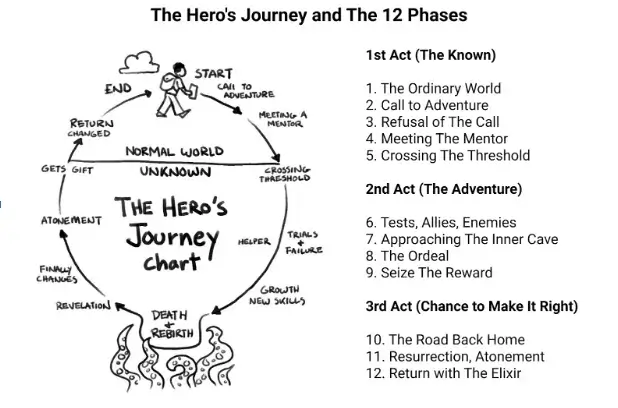Content marketing is a critical tool in the marketing toolbox. And the numbers speak for themselves. According to a study by Semrush, 97% of marketers use content marketing in their marketing strategy.
But if nearly every marketer uses this tactic, how do you stand out? It isn't enough to whip up a 1,000-word article and publish it on your blog three times a week.
It is essential to write engaging blog content that resonates with your audience. What about a juicy story to get your readers hooked?
This post will discuss how you can use masterful storytelling techniques to improve your content marketing strategy, drive leads, and increase conversions.
Let's dive in.
Why is Storytelling Important for Content Marketing?
Storytelling is a powerful tool for content marketing. Stories connect with your audience and help them understand what your brand is all about.
Skip to: 3 Storytelling Best Practices in Content Marketing

When you tell a story, your audience gets invested in it because they can relate to it. Readers feel a deeper connection and stay engaged when they see themselves in the story.
Storytelling is memorable. If you can tell a story that leaves an impression on someone, that person will remember it and often associate it with your brand.
There are a few things you need to keep in mind to make sure your storytelling style works well for content marketing purposes:
-
Be consistent with your style and tone throughout your content (including headlines) so that people know what type of storyteller you are before they even read anything from you.
-
Make sure that every piece of content has some value or message behind it so that people don't just "glaze over" when scrolling through blogs or social media feeds.
-
Try out different types of stories so that people stay energized.
But don't worry if you need a team of talented writers to create a masterful story on your blog every week, don't worry. There are plenty of resources available to save you time and money.
And outsourcing content creation is more common than you think. The 2020 Content Marketing Report found that 84% of B2B marketers outsource their content creation, while 55% of B2C marketers do the same.
There are a few options for outsourcing content creation. You can leverage a content writing service or use an AI-generated writing tool.
A content writing service is a one-stop-shop for high-quality content, while AI-generated writing tools can help you generate first drafts but certainly need some human touches.
3 Storytelling Best Practices in Content Marketing
Storytelling is a powerful tool for content marketers. Here are three best practices for improving your content marketing by mastering the basic rules of storytelling.

1. Establish authenticity
Great content marketing is authentic, transparent, and genuine. That is where storytelling comes in.
Storytelling is about creating a narrative that's authentic and relatable. It's about connecting with your customers' emotions and helping them understand your value.
It's about making them feel like they can relate to you and what you're doing and helping them feel like they can trust you.
If you can do these things, you can establish an authenticity that allows people to connect with your brand deeper and trust your product or services.
Good storytelling doesn't have to be overly promotional to spark an interest in your product. For example, this Tiktok featuring the CEO of Tailor Brands is an excellent subtle advertisement for the business LLC formation service.
Yali Saar gives an inspiring message for entrepreneurs, encouraging them to start their businesses despite fearing failure.
Not so coincidentally, his company offers full-service business building from formation to branding.
When you tell stories that relate to your customer's pain points, you establish yourself as an authority in their eyes.
You also position yourself as someone who understands and cares about their problems, making them more likely to trust and purchase from you.
2. Use the classics
You can also use the storytelling classics to your advantage. The most compelling stories have a universal theme. Suppose you're writing an article about how a business owner built their brand from scratch.
In that case, you can tell your account using a classic element of a character who overcomes obstacles or problems through determination, action, or strategy.
By now, you probably recognize this as the hero's journey — a narrative structure that storytellers have used for thousands of years.
It's a great way to tell a story about how failure leads to success. That's why many of the most successful startup books leverage the hero's journey to narrate the trials and tribulations of finding success in the business world.

The hero's journey is the story that leaves you amazed and inspired. It's a story that shows the power of the human spirit and often ends with the hero overcoming incredible odds to achieve their goal.
As marketers, we can use this storytelling technique to drive the same reaction in our content marketing efforts.
3. Focus on customer pain points
To tell a story that people want to listen to, you need to know who they are and what they care about.
Identify their pain points and what makes them tick so you can help solve those problems through your storytelling.
Think about it: if you need to address their issues or provide them with value, they will want to avoid engaging with your content and will find something more appealing.
When writing an article, crafting a brochure, or creating a video, consider what your target audience needs help with. What problems are they facing in their lives? What would make them feel better?
If your target audience is parents with young children, they have difficulty getting their kids to sleep. They're looking for new ways to make meals more fun.
Or they need help managing their busy schedules. So, use those struggles as a jumping-off point for content.
Once you've identified some of these issues, it's time to brainstorm solutions that'll work for them. That could mean writing a how-to guide on your blog about fun mealtime recipes or partnering with a mom who can share their sleep training tips in a YouTube video.
Additionally, another effective approach could be implementing YouTube automation strategies to streamline your content creation and distribution process.
By leveraging YouTube automation, you can optimize your video with the help of a video production company, scheduling, and promotion, ultimately maximizing your reach and engagement on the platform.
In this video, Susan Yara mentions Baby Sleep Trainer, who helped her sleep train her newborn. This partnership is excellent for both brands.
It provides relevant, helpful content for the mom vlogger and generates warm leads for the sleep trainer.
Wrapping Up
The art of storytelling is an important skill to master if you want to be a successful content marketer.
It's about telling a good tale and knowing how to weave together the right tools and techniques to help you connect with your audience.
Find ways to connect with your audience and pull at their heartstrings. Using narrative elements has a profound effect on how your content is perceived.
The goal is to build trust and authenticity to stand out in the sea of content on the internet. The more you practice these skills, the better they'll get over time.
Author Bio
Nidhi Kala is a freelance writer for B2B SaaS brands in marketing, HR, and eCommerce. Her artistic mind is buried in creating a new journal spread or exploring calligraphy scripts when she's not writing. Connect with her on LinkedIn.




